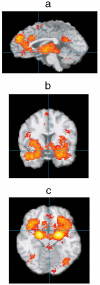The experience of emotion
- PMID: 17002554
- PMCID: PMC1934613
- DOI: 10.1146/annurev.psych.58.110405.085709
The experience of emotion
Abstract
Experiences of emotion are content-rich events that emerge at the level of psychological description, but must be causally constituted by neurobiological processes. This chapter outlines an emerging scientific agenda for understanding what these experiences feel like and how they arise. We review the available answers to what is felt (i.e., the content that makes up an experience of emotion) and how neurobiological processes instantiate these properties of experience. These answers are then integrated into a broad framework that describes, in psychological terms, how the experience of emotion emerges from more basic processes. We then discuss the role of such experiences in the economy of the mind and behavior.
Figures


References
-
- Adolphs R. The neurobiology of social cognition. Curr. Opin. Neurobiol. 2001;11:231–39. - PubMed
-
- Adolphs R, Lee GP, Tranel D, Damasio AR. Bilateral damage to the human amygdala early in life impairs knowledge of emotional arousal. Soc. Neurosci. Abstr. 1997;23:1582.
-
- Allman JM, Hakeem A, Erwin JM, Nimchinsky E, Hoff P. The anterior cingulate cortex: the evolution of an interface between emotion and cognition. Ann. NY Acad. Sci. 2001;935:107–17. - PubMed
-
- Amaral DG, Behniea H, Kelly JL. Topographical organization of projections from the amygdala to the visual cortex in the Macaque monkey. Neuroscience. 2003;118:1099–120. - PubMed
-
- Anand A, Li Y, Wang Y, Wu J, Gao S, et al. Activity and connectivity of brain mood regulating circuit in depression: a functional magnetic resonance study. Biol. Psychiatry. 2005;57:1079–88. - PubMed
Publication types
MeSH terms
Grants and funding
LinkOut - more resources
Full Text Sources

